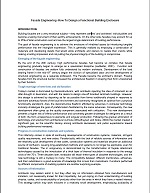3-Dimensional Steady State Thermal Analysis
3-Dimensional Steady State Thermal Analysis are performed chiefly to assess the condensation risk of those details that escape the 2D representation, such as shading brackets, anchors, and framing intersections in verification of impact of thermal bridging caused by components penetrating the heat-control layer in two directions.

The image above shows the Sample 3-Dimensional Steady State Thermal Analysis, revealing the thermal irregularities at the skylight rafter. Would the water condensing underside the glass be drained safely outside in a winter? Only the 3D simulation can answer a question like this. In this example, the condensate drainage channels were found to freeze, which would prevent water discharge, and lead to water damage.
Note to Specifiers: If you specify 3D analysis, please kindly consider getting a second opinion. We observed some architectural specifications ask for 3D simulations to verify either irrelevant or inferior performance requirements. Not that we mind very much, but in our reports we have a fiduciary duty to report any observed weaknesses to contractors who hired us to perform the work. Your client may be unhappy to find out, because these simulations tend to be expensive.
You may also be interested in reading the following free technical publication PDF: Using 3D Thermal Modeling to Improve Performance Requirements (PDF, size 353 kB) by Karol Kazmierczak – JBED 2/2010

 Condensation Risk Assessment
Condensation Risk Assessment Facade Access
Facade Access Facade Engineering. How To Design a Functional Building Enclosure
Facade Engineering. How To Design a Functional Building Enclosure Facade Impact Resistance Manual
Facade Impact Resistance Manual Foggy Glass Disease
Foggy Glass Disease How To Write and Read a Forensic Report
How To Write and Read a Forensic Report Movements and Tolerances
Movements and Tolerances Review of Curtain Walls, Focusing on Design Problems and Solutions
Review of Curtain Walls, Focusing on Design Problems and Solutions Transitions: How to Design Facade Interfaces
Transitions: How to Design Facade Interfaces When You Need A Window – Solar Design
When You Need A Window – Solar Design
December 25th, 2012 at 6:57 pm
[…] […]